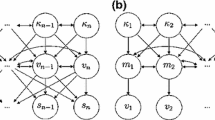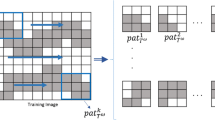Abstract
We present here a method for generating realizations of the posterior probability density function of a Gaussian Mixture linear inverse problem in the combined discrete-continuous case. This task is achieved by extending the sequential simulations method to the mixed discrete-continuous problem. The sequential approach allows us to generate a Gaussian Mixture random field that honors the covariance functions of the continuous property and the available observed data. The traditional inverse theory results, well known for the Gaussian case, are first summarized for Gaussian Mixture models: in particular the analytical expression for means, covariance matrices, and weights of the conditional probability density function are derived. However, the computation of the weights of the conditional distribution requires the evaluation of the probability density function values of a multivariate Gaussian distribution, at each conditioning point. As an alternative solution of the Bayesian inverse Gaussian Mixture problem, we then introduce the sequential approach to inverse problems and extend it to the Gaussian Mixture case. The Sequential Gaussian Mixture Simulation (SGMixSim) approach is presented as a particular case of the linear inverse Gaussian Mixture problem, where the linear operator is the identity. Similar to the Gaussian case, in Sequential Gaussian Mixture Simulation the means and the covariance matrices of the conditional distribution at a given point correspond to the kriging estimate, component by component, of the mixture. Furthermore, Sequential Gaussian Mixture Simulation can be conditioned by secondary information to account for non-stationarity. Examples of applications with synthetic and real data, are presented in the reservoir modeling domain where realizations of facies distribution and reservoir properties, such as porosity or net-to-gross, are obtained using Sequential Gaussian Mixture Simulation approach. In these examples, reservoir properties are assumed to be distributed as a Gaussian Mixture model. In particular, reservoir properties are Gaussian within each facies, and the weights of the mixture are identified with the point-wise probability of the facies.
Access this chapter
Tax calculation will be finalised at checkout
Purchases are for personal use only
Similar content being viewed by others
References
Alspach DL, Sorenson HW (1972) Nonlinear Bayesian estimation using Gaussian sum approximation. IEEE Trans Autom Control 17:439–448. doi:10.1109/TAC.1972.1100034
Dempster AP, Laird NM, Rubin DB (1977) Maximum likelihood from incomplete data via the EM algorithm. J R Stat Soc, Ser B, Methodol 39(1):1–38. doi:10.2307/2984875
Deutsch C, Journel AG (1992) GSLIB: geostatistical software library and user’s guide. Oxford University Press, London
Dovera L, Della Rossa E (2011) Multimodal ensemble Kalman filtering using Gaussian mixture models. Comput Geosci 15(2):307–323. doi:10.1007/s10596-010-9205-3
Gilardi N, Bengio S, Kanevski M (2002) Conditional Gaussian mixture models for environmental risk mapping. In: Proc. of IEEE workshop on neural networks for signal processing, pp 777–786. doi:10.1109/NNSP.2002.1030100
Goovaerts P (1997) Geostatistics for natural resources evaluation. Oxford University Press, London
Grana D, Della Rossa E (2010) Probabilistic petrophysical-properties estimation integrating statistical rock physics with seismic inversion. Geophysics 75(3):O21–O37. doi:10.1190/1.3386676
Hansen TM, Journel AG, Tarantola A, Mosegaard K (2006) Linear inverse Gaussian theory and geostatistics. Geophysics 71:R101–R111. doi:10.1190/1.2345195
Hasselblad V (1966) Estimation of parameters for a mixture of normal distributions. Technometrics 8(3):431–444. doi:10.2307/1266689
Hastie T, Tibshirani R (1996) Discriminant analysis by gaussian mixtures. J R Stat Soc B 58(1):155–176. doi:10.2307/2346171
Hastie T, Tibshirani R, Friedmann J (2009) The elements of statistical learning. Springer, Berlin
Mosegaard K, Tarantola A (1995) Monte Carlo sampling of solutions to inverse problems. J Geophys Res 100:12431–12447. doi:10.1029/94JB03097
Reynolds DA, Quatieri TF, Dunn RB (2000) Speaker verification using adapted Gaussian mixture models. Digit Signal Process 10(1–3):19–41. doi:10.1006/dspr.1999.0361
Sung HG (2004) Gaussian mixture regression and classification. PhD thesis, Rice University
Tarantola A (2005) Inverse problem theory. SIAM, Philadelphia
Acknowledgements
We acknowledge Stanford Rock Physics and Borehole Geophysics Project and Stanford Center for Reservoir Forecasting for the support, and Eni E&P for the permission to publish this paper.
Author information
Authors and Affiliations
Corresponding author
Editor information
Editors and Affiliations
Rights and permissions
Copyright information
© 2012 Springer Science+Business Media Dordrecht
About this chapter
Cite this chapter
Grana, D., Mukerji, T., Dovera, L., Della Rossa, E. (2012). Sequential Simulations of Mixed Discrete-Continuous Properties: Sequential Gaussian Mixture Simulation. In: Abrahamsen, P., Hauge, R., Kolbjørnsen, O. (eds) Geostatistics Oslo 2012. Quantitative Geology and Geostatistics, vol 17. Springer, Dordrecht. https://doi.org/10.1007/978-94-007-4153-9_19
Download citation
DOI: https://doi.org/10.1007/978-94-007-4153-9_19
Publisher Name: Springer, Dordrecht
Print ISBN: 978-94-007-4152-2
Online ISBN: 978-94-007-4153-9
eBook Packages: Mathematics and StatisticsMathematics and Statistics (R0)




